
Nagykörút or Grand Boulevard is one of the most central and busiest parts of Budapest, a major thoroughfare built by 1896, Hungary's Millennium. It forms a semicircle connecting two bridges of the Danube, Margaret Bridge on the north and Petőfi Bridge on the south. Usually the part inside and around this semicircle is counted as the city centre of Budapest.

Kiskörút or Small Boulevard is a major thoroughfare in Budapest. It forms an incomplete semicircle between Deák Square and Fővám Square. It is the border of the southern part of District 5, the innermost district of Pest. As opposed to Nagykörút, it only touches the Danube at its southern end.

The Rákóczi were a Hungarian noble family in the Kingdom of Hungary between the 13th century and 18th century. Their name is also spelled Rákoci, Rakoczi and Rakoczy in some foreign (English) sources. The family was named after Rákóc.

Budapest Keleti (eastern) railway station is the main international and inter-city railway terminal in Budapest, Hungary.
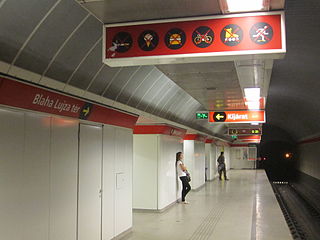
Blaha Lujza tér is a station of the M2 (East-West) line of the Budapest Metro. It is a major transport junction. Tram numbers 4 and 6 stop here as do Express Buses 7 red and 173.

Kossuth Lajos square is situated in the Lipótváros neighbourhood of Budapest, Hungary, on the bank of the Danube. Its most notable landmark is the Hungarian Parliament Building. There is a station of the M2 (East-West) line of the Budapest Metro on the square as well as a stop for the scenic Tram No. 2.

Kodály körönd is a circus in Budapest, Hungary, at the intersection of Andrássy Avenue and Felsőerdősor u., with beautifully painted old buildings and statues of four of Hungary's great heroes in each corner. It is also a station on the yellow M1 line of the Budapest Metro. The four heroes are:
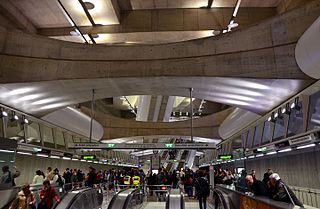
Kálvin tér is a transfer station on the M3 and the M4 lines of the Budapest Metro. It is located beneath the eponymous square, named after John Calvin.

Gyömrő is a town in Pest county, Budapest metropolitan area, Hungary. The City of Gyömrő is situated in the center of the hilly region of Monor, in the outskirt of the capital city, Budapest. The whole territory of Gyömrő is 26,51 km², its internal area is 6.45 km². The number of inhabitants is about 15,290.
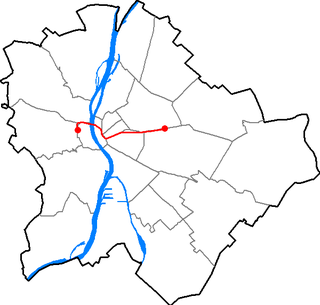
Line 2 is the second line of the Budapest Metro. The line runs east from Déli pályaudvar in north-central Buda under the Danube to the city center, from where it continues east following the route of Rákóczi út to its terminus at Örs vezér tere.
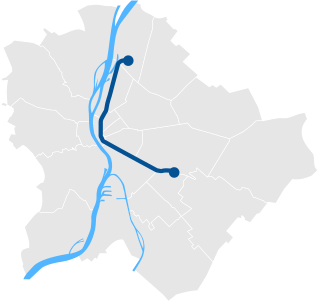
Line 3 is the third and longest line of the Budapest Metro. It runs in a general north-south direction parallel to the Danube on the Pest side, roughly following Váci út south from Újpest to the city center, then following the route of Üllői út southeast to Kőbánya-Kispest. Its daily ridership is estimated at 626,179. Like Line 1, it does not serve Buda.
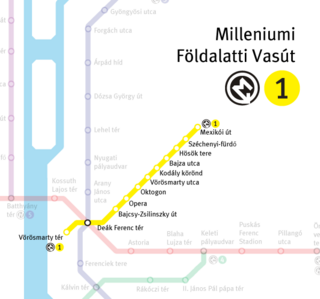
Line 1 is the oldest line of the Budapest Metro. It is known locally as "the underground", while the M2, M3 and M4 are called "metró". It is the third oldest underground after the London Underground and the Mersey Railway, the third rapid transit rail line worldwide of any type to exclusively use electric traction, and the first on the European mainland. It was built from 1894 to 1896.

Memento Park is an open-air museum in Budapest, Hungary, dedicated to monumental statues and sculpted plaques from Hungary's Communist period (1949–1989). There are statues of Lenin, Marx, and Engels, as well as several Hungarian Communist leaders. The park was designed by Hungarian architect Ákos Eleőd, who won the competition announced by the Budapest General Assembly in 1991. On public transport diagrams and other documents the park is usually shown as Memorial Park.

The tram network of Budapest is part of the mass transit system of Budapest, the capital city of Hungary. The tram lines serve as the second most important backbone of the transit system, carrying almost 100 million more passengers annually than the Budapest Metro.

Rákóczi út is one of the busiest arterial roads in Budapest, Hungary. It runs in an east-west direction through the city.

Szent Gellért tér is a station of Line 4 of the Budapest Metro. It is located beneath the eponymous square, named after Szent Gellért, patron saint of Budapest, and was opened in March 2014. Artist Tamás Komoróczky was commissioned to design the mosaic interior decoration of the inner platform below the University of Technology and Economics. It is the deepest station on Line 4.
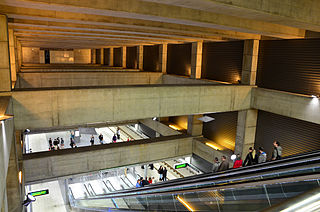
II. János Pál pápa tér is a station on Line 4 of the Budapest Metro. It is located beneath the eponymous square, named after John Paul II.



















